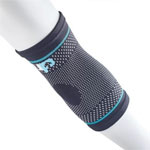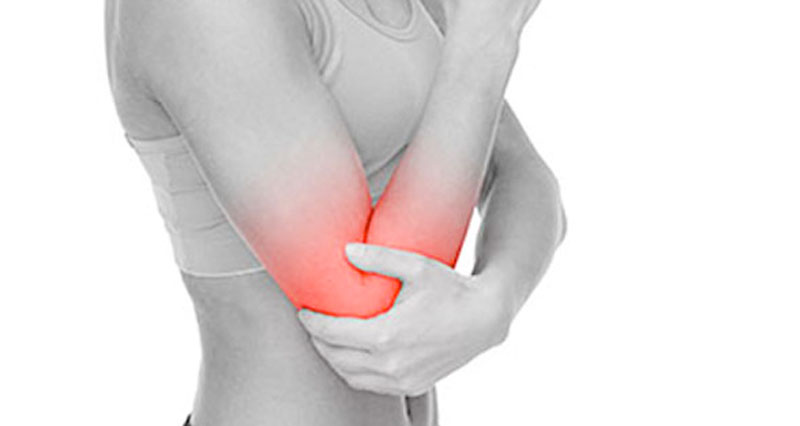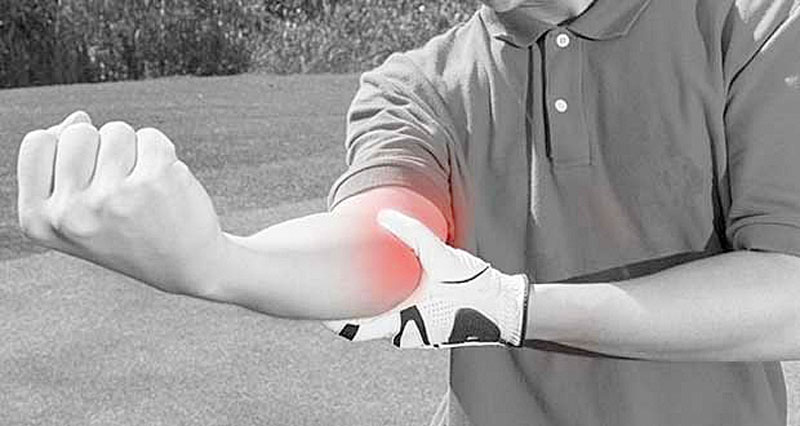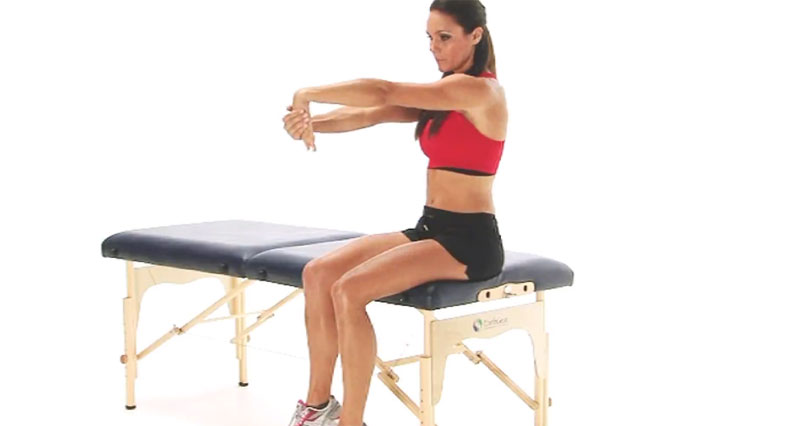Acute elbow injuries occur suddenly and include fractures, tendon ruptures, dislocations, and ligament sprains. Long term chronic elbow injuries are often the result of overuse. However, they may flare up suddenly as an acute injury. Here we explain the causes of sudden onset, acute elbow pain.
Elbow ligament sprains
A sprain is the stretching or tearing of a ligament. Ligaments join bone to bone and provide a high degree of stability to joints. However, often from direct trauma or twisting they become injured.
Elbow hyperextension injury
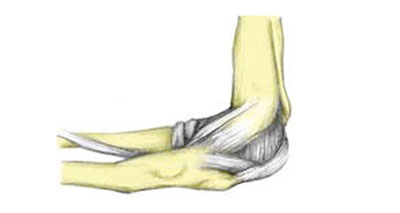
An elbow hyperextension injury occurs when the elbow is bent back the wrong way. This over-straightening causes damage to the ligaments and structures of the elbow.
- More on Elbow hyperextension injury
Medial elbow ligament sprain
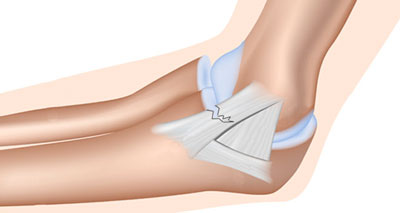
A medial collateral ligament injury is an acute sprain of the ligaments on the inside of the elbow. Symptoms include:
- Pain and tenderness on the inside of the elbow.
- Bruising and swelling may be present for more severe injuries.
Impact injuries causing damage to the medial ligament usually involve a lateral force (towards the outside) being applied to the forearm, placing the medial (inner) joint under stress.
- More on Medial elbow ligament sprain
Elbow fractures
An elbow fracture is a break in one of the bones which form the elbow joint. There are three bones that could be broken: the Humerus (upper arm bone), Ulna, and Radius (two forearm bones). Acute elbow fracture injuries are caused by a fall or a hard impact, and especially because there can be further potential complications, medical assistance should be sought immediately. Common elbow fractures include:
Radial Head Fracture
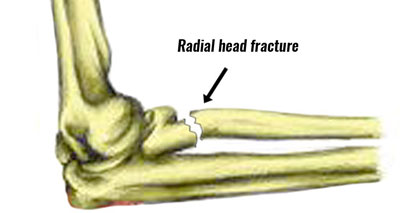
A radial head fracture is a break to the radius bone in the forearm just below the elbow joint and usually occurs as a result of a fall onto an outstretched hand.
- Symptoms of a radial head fracture of the humerus include instant pain at the time of injury, which is located on the inside of the elbow joint.
- Immediate swelling with difficulty turning the arm over and pain when attempting to bend or straighten the elbow.
- There are different grades of radial head fracture, which affects how it is treated. Most radial head fractures are not displaced, meaning the fractured fragment of bone does not move away from the fracture site.
- More on Radial head fracture
Olecranon fracture
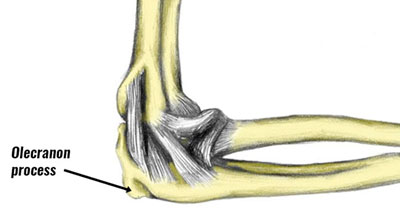
The olecranon is the large bony prominence at the back of the elbow on the ulna forearm bone. It is usually fractured from a direct impact or falls onto a bent elbow.
- Sudden intense pain at the back of the elbow will be felt at the time of injury.
- The patient will in most cases be unable to straighten the elbow.
- Rapid swelling and bruising may start to appear. Trying to move the elbow will be painful and the back of the elbow will be very tender to touch.
- More on Olecranon fracture
Fractures of the Coronoid Process
The coronoid process is a protrusion of bone on the Ulna, at the front end of the ‘cup’ in which the end of the humerus sits. This part is fractured through a fall onto a straightened elbow and is often associated with an elbow dislocation.
- Symptoms include pain, tenderness, and swelling over the front of the elbow joint.
- Non-displaced fractures can be treated with immobilization in a cast for 3-4 weeks.
- Displaced bone fragments may require surgery.
Intercondylar Fractures
An intercondylar fracture is a break to the Humerus (upper arm) bone, between the medial and lateral condyles at the lower end of the bone. Fractures here are described as being Y or T shaped and have varying degrees of displacement of the fractured bone segment.
- It is usually caused by a blow to a flexed (bent) elbow.
- The patient will usually be holding their arm in a flexed position with the palm facing downwards.
- Their forearm may appear shorter than the other one.
- Treatment usually involves surgery as the fragment is usually displaced.
Condylar Fractures
The two prominent parts of the Humerus on either side of the elbow are known as the Epicondyles (or just condyles). A condylar fracture is a break to one of these bones. The outer (lateral) condyle is more likely to fracture than the inner (medial) one. Injury to both is due to impacts or falls.
- The patient complains of pain, swelling, and a limited range of motion.
- It is common to feel a crunching feeling or sound when trying to bend the elbow.
- In non-displaced fractures immobilization in a cast or splint is sufficient.
- If the fragment has become displaced then surgery is required.
Capitellum Fracture
The Capitellum is the rounded lower end of the Humerus, which articulates with the radius of the forearm. Fractures to this area occur most often through a fall onto an outstretched hand.
- Symptoms include pain and swelling at the front of the elbow.
- Most fractures are displaced and so require surgical fixation.
Dislocated elbow
Elbow dislocations are the second most common dislocations in adults, behind a dislocated shoulder. The elbow is a very stable joint and so it requires a lot of force to dislocate it. Thankfully full dislocations are rare. A motor accident or bad fall is more likely to cause acute elbow injuries.
- Symptoms include extreme pain with obvious deformity with bruising on the inside, and outside of the elbow.
- If a fractured or dislocated elbow is suspected then seek medical attention immediately.
Bruised Elbow/Contusions
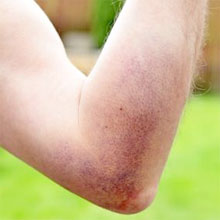
A bruised elbow or elbow contusion is a common cause of acute elbow pain. It usually occurs as a result of a fall or impact on the elbow. The elbow will appear bruised and will be tender to touch. Rest, ice and compression can usually treat this elbow injury, but it should be monitored for signs of more serious damage.
- Bruised elbow symptoms result from sudden pain on impact from a fall or fast-moving ball. Bruising and discolouration of the skin around the elbow gradually appear.
- The area will be tender to touch and there may be some swelling. Movement of the elbow may be mildly painful or limited.
- It is important to look out for symptoms that may indicate more serious damage to the elbow such as a fracture.
- If you have nerve-related symptoms, for example, numbness, tingling, or pins and needles then you may have an Ulna nerve contusion.
Rest the arm. Sit with the arm elevated and use a compression bandage to reduce swelling and bleeding. Apply ice to reduce bleeding and swelling. If the elbow is very painful, consider a fracture and seek medical attention. If a fracture is suspected an X-ray should be taken to confirm the diagnosis.

